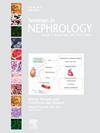小儿重症疟疾急性肾损伤病因之谜的探索。
IF 3.5
3区 医学
Q2 UROLOGY & NEPHROLOGY
引用次数: 0
摘要
急性肾损伤(AKI)在小儿重症疟疾中得到越来越多的认识,但缺乏对促成机制的理解。我们评估了脑型疟疾患儿AKI的潜在血流动力学因素。用尿中性粒细胞明胶酶相关脂钙蛋白(uNGAL)值bb0 125 ng/mL来定义结构性AKI。我们纳入了62例患者(中位年龄53.5[31,71]个月),其中38例(61%)在入院时患有AKI。Blantyre昏迷评分6/L (aOR 4.2, 95%CI 1.3 ~ 12.8, P = 0.03)与AKI相关。AKI患儿的心脏指数(CI)较低(P = 0.01),全身血管阻力指数(SVRI)较高(P = 0.03)。AKI与不良预后相关(后遗症或死亡:or 5.7, 95%CI 1.5-19, P = 0.01)。AKI在脑型疟疾患儿中很常见。血流动力学测量表明血管张力升高有助于AKI的发生。本文章由计算机程序翻译,如有差异,请以英文原文为准。
Chasing the Mystery of the Etiology of Acute Kidney Injury in Pediatric Severe Malaria
Acute kidney injury (AKI) is increasingly recognized in pediatric severe malaria, but an understanding of contributory mechanisms is lacking. We evaluated potential hemodynamic contributors to AKI in children with cerebral malaria. Structural AKI was defined using urine neutrophil gelatinase–associated lipocalin (uNGAL) values >125 ng/mL. We included 62 patients (median age 53.5 [31, 71] months), and 38 (61%) had AKI at hospital admission. Blantyre Coma Score <2 (aOR 9.1, 95%CI 1.8-43, P = .003), a low-flow phenotype on transcranial doppler ultrasound (TCD) (aOR 2.3, 95%CI 1.1-7.7, P = .05), and thrombocytopenia <75,000 × 106/L (aOR 4.2, 95%CI 1.3-12.8, P = .03) were associated with AKI. Cardiac index (CI) was lower (P = .01) and systemic vascular resistive index (SVRI) higher (P = .03) in children with AKI compared to those without. AKI was associated with poor outcome (sequelae or death: OR 5.7, 95%CI 1.5-19, P = .01). AKI is common in children with cerebral malaria. Hemodynamic measurements suggest increased vascular tone contributes to AKI.
求助全文
通过发布文献求助,成功后即可免费获取论文全文。
去求助
来源期刊

Seminars in nephrology
医学-泌尿学与肾脏学
CiteScore
5.60
自引率
0.00%
发文量
27
审稿时长
6-12 weeks
期刊介绍:
Seminars in Nephrology is a timely source for the publication of new concepts and research findings relevant to the clinical practice of nephrology. Each issue is an organized compendium of practical information that serves as a lasting reference for nephrologists, internists and physicians in training.
 求助内容:
求助内容: 应助结果提醒方式:
应助结果提醒方式:


